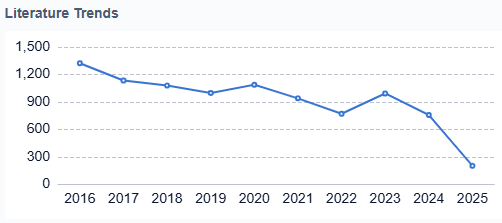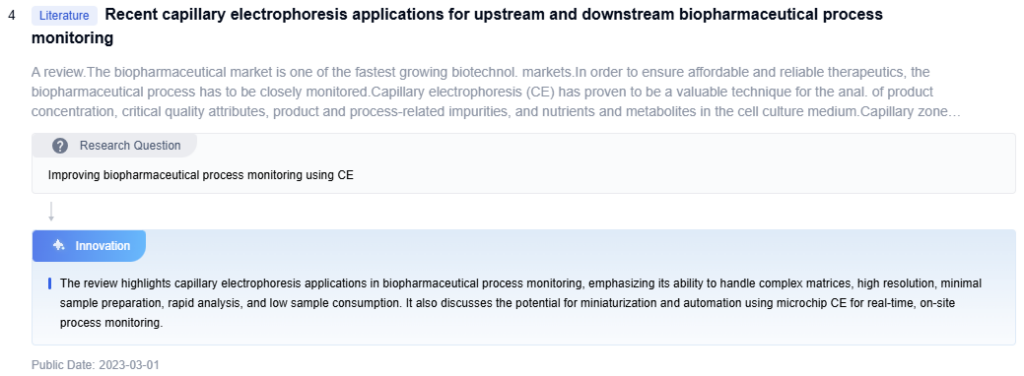
CE Evolution and Objectives
Capillary electrophoresis (CE) has emerged as a powerful analytical technique since its inception in the 1980s. This method, which separates molecules based on their size and charge in a narrow capillary tube, has revolutionized various fields, including biochemistry, pharmaceuticals, and forensic science. The evolution of CE has been marked by significant technological advancements and a growing range of applications. Initially developed as a high-resolution alternative to traditional gel electrophoresis, CE has since expanded to encompass a variety of modes, including capillary zone electrophoresis (CZE), micellar electrokinetic chromatography (MEKC), and capillary gel electrophoresis (CGE).
Exploring the next big breakthroughs in battery tech? Eureka Technical Q&A connects you with industry experts who can break down emerging materials, performance metrics, and commercialization challenges—helping you understand which battery technologies are truly positioned to disrupt the market.
The primary objectives driving the development of CE technology are increased sensitivity, improved resolution, and enhanced throughput. Researchers and industry professionals are continually striving to push the boundaries of what CE can achieve. One key goal is to improve the detection limits, allowing for the analysis of increasingly minute sample quantities. This is particularly crucial in fields such as proteomics and metabolomics, where sample availability is often limited. Another important objective is to enhance the separation efficiency, enabling the resolution of complex mixtures with closely related compounds. This is especially relevant in pharmaceutical analysis and biomarker discovery.

The trend towards miniaturization and automation has led to the development of microchip CE systems, which aim to integrate sample preparation, separation, and detection onto a single chip. This “lab-on-a-chip” approach aligns with the broader movement towards point-of-care diagnostics and personalized medicine. Additionally, there is a growing focus on coupling CE with other analytical techniques, such as mass spectrometry (CE-MS), to provide more comprehensive and informative analyses.
As environmental concerns become increasingly prominent, there is also a push towards making CE more sustainable. This includes developing green chemistry approaches, reducing solvent consumption, and minimizing waste generation. The integration of CE with online sample preparation techniques is another area of active research, aiming to streamline workflows and reduce manual handling.

Looking ahead, the future of CE is likely to be shaped by advancements in nanotechnology, artificial intelligence, and big data analytics. These technologies have the potential to further enhance the capabilities of CE, enabling more sophisticated separations, intelligent data interpretation, and predictive modeling of separation behaviors. As CE continues to evolve, its role in various scientific and industrial applications is expected to expand, cementing its position as a versatile and indispensable analytical tool.
CE Market Demand Analysis
Capillary electrophoresis (CE) has witnessed significant growth in market demand over the past decade, driven by its versatility and applicability across various industries. The global CE market is projected to expand at a CAGR of 6.8% from 2021 to 2028, reaching a value of $2.3 billion by the end of the forecast period. This growth is primarily attributed to the increasing adoption of CE in pharmaceutical and biotechnology research, clinical diagnostics, and environmental analysis.
In the pharmaceutical sector, CE has become an indispensable tool for drug development and quality control processes. The rising demand for biopharmaceuticals and personalized medicine has further fueled the need for high-resolution separation techniques like CE. Additionally, the growing emphasis on protein characterization and analysis in the biotechnology industry has created a substantial market for CE instruments and consumables.
The clinical diagnostics segment represents another significant driver of CE market demand. With the increasing prevalence of chronic diseases and the need for rapid, accurate diagnostic tools, CE has found widespread application in areas such as genetic testing, biomarker detection, and therapeutic drug monitoring. The COVID-19 pandemic has also highlighted the importance of CE in viral detection and vaccine development, further boosting market growth.
Environmental analysis is emerging as a promising application area for CE, driven by stringent regulations on water quality and pollution control. The technique’s ability to detect and quantify trace levels of contaminants in environmental samples has led to its increased adoption in environmental monitoring programs worldwide.
Geographically, North America dominates the CE market, accounting for approximately 40% of the global share. This can be attributed to the presence of major pharmaceutical and biotechnology companies, well-established research infrastructure, and favorable government initiatives. However, the Asia-Pacific region is expected to witness the highest growth rate in the coming years, driven by increasing R&D investments, expanding healthcare infrastructure, and rising awareness about advanced analytical techniques.
The CE consumables segment, including capillaries, reagents, and kits, is anticipated to grow at a faster rate compared to instruments. This trend is due to the recurring nature of consumable purchases and the continuous development of specialized reagents for specific applications.
Despite the positive market outlook, challenges such as the high cost of CE systems and the availability of alternative separation techniques may hinder market growth to some extent. However, ongoing technological advancements, such as the integration of CE with mass spectrometry and the development of miniaturized CE systems, are expected to create new opportunities and drive market expansion in the coming years.
CE Technical Hurdles
Capillary electrophoresis (CE) has emerged as a powerful analytical technique, yet it faces several technical challenges that hinder its widespread adoption and limit its performance in certain applications. One of the primary hurdles is the limited sensitivity of CE, particularly when compared to other separation techniques like HPLC. This is largely due to the small sample volumes that can be injected into the capillary and the short optical path length for detection. Researchers are actively working on developing novel detection methods and sample concentration techniques to overcome this limitation.
Another significant challenge is the reproducibility and robustness of CE separations. Variations in capillary surface properties, buffer composition, and environmental conditions can lead to inconsistent results. This issue is particularly pronounced in complex biological samples, where matrix effects can significantly impact separation efficiency and resolution. Efforts are underway to develop more stable capillary coatings and improved buffer systems to enhance reproducibility.

The relatively low throughput of CE compared to other analytical techniques is also a concern, especially in high-volume industrial applications. While multiplexed CE systems have been developed, they often come with increased complexity and cost. Researchers are exploring ways to increase throughput without compromising separation quality, such as developing parallel capillary arrays and optimizing injection and separation protocols.
Capillary electrophoresis also faces challenges in the analysis of large biomolecules, particularly proteins. Protein adsorption to the capillary wall can lead to peak broadening, reduced efficiency, and irreproducible results. While various capillary coatings have been developed to mitigate this issue, finding a universal solution that works across different protein types remains elusive.
The integration of CE with other analytical techniques, such as mass spectrometry (CE-MS), presents its own set of challenges. Interface design, maintaining stable electrospray, and achieving compatibility between CE buffers and MS requirements are ongoing areas of research. Improving these interfaces is crucial for expanding the applicability of CE in fields like proteomics and metabolomics.

Lastly, the miniaturization of CE systems for point-of-care diagnostics and on-site analysis is an active area of development. However, challenges in sample handling, detection sensitivity, and system integration at the microscale need to be addressed. Researchers are exploring microfluidic technologies and novel detection schemes to overcome these hurdles and bring CE-based analysis closer to real-world applications.
CE Development Timeline


CE Industry Leaders
The capillary electrophoresis market is in a growth phase, driven by increasing demand in pharmaceutical and biotechnology sectors. The global market size is projected to expand significantly, with a CAGR of around 6-8% in the coming years. Technologically, the field is advancing rapidly, with key players like Life Technologies Corp., Beckman Coulter, Inc., and Hitachi Ltd. leading innovation. These companies are focusing on improving sensitivity, resolution, and automation. Emerging challenges include miniaturization, integration with other analytical techniques, and development of high-throughput systems. Academic institutions like Zhejiang University and Fudan University are contributing to fundamental research, while companies like ProteinSimple and ARKRAY, Inc. are commercializing novel applications, indicating a dynamic and competitive landscape.
 Life Technologies Corp.
Life Technologies Corp.
Technical Solution
Life Technologies has developed advanced capillary electrophoresis systems with high-throughput capabilities. Their technology incorporates multi-capillary arrays and automated sample handling, allowing for simultaneous analysis of multiple samples. They have also implemented laser-induced fluorescence detection methods for enhanced sensitivity and specificity in DNA sequencing and protein analysis applications.
Strengths: High-throughput capabilities, automated sample handling, and advanced detection methods. Weaknesses: High initial investment cost and complexity in operation for some users.
 Beckman Coulter, Inc.
Beckman Coulter, Inc.
Technical Solution
Beckman Coulter has pioneered capillary electrophoresis systems with integrated microfluidic chips. Their technology combines traditional capillary electrophoresis principles with lab-on-a-chip concepts, resulting in miniaturized systems with reduced sample and reagent consumption. They have also developed specialized software for data analysis and interpretation, enhancing the overall efficiency of the CE process.
Strengths: Miniaturization, reduced sample requirements, and integrated data analysis.
Weaknesses: Limited scalability for very high-throughput applications.
 Hitachi Ltd.
Hitachi Ltd.
Technical Solution
Hitachi has developed capillary electrophoresis systems with a focus on environmental and food safety applications. Their technology incorporates advanced sample preparation techniques and specialized capillary coatings to improve separation efficiency and reduce matrix effects. They have also implemented novel detection methods, such as mass spectrometry coupling, to enhance the identification and quantification of complex analytes in challenging samples.
Strengths: Specialized applications in environmental and food safety, advanced sample preparation techniques.
Weaknesses: May have limited versatility for other application areas.
 Applied Biosystems LLC
Applied Biosystems LLC
Technical Solution
Applied Biosystems has developed capillary electrophoresis systems with a strong focus on genomics and proteomics applications. Their technology incorporates high-resolution capillary arrays and advanced polymer formulations for DNA sequencing and fragment analysis. They have also implemented automated sample loading and data analysis software, streamlining the workflow for large-scale genetic studies and clinical diagnostics.
Strengths: Specialized in genomics and proteomics applications, high-resolution capabilities. Weaknesses: May have limited applicability in non-biological fields.
 ProteinSimple
ProteinSimple
Technical Solution
ProteinSimple has developed innovative capillary electrophoresis systems specifically designed for protein analysis. Their technology incorporates automated immunoassay techniques with capillary electrophoresis principles, allowing for rapid and quantitative protein detection. They have also implemented microfluidic cartridges and simplified user interfaces, making protein analysis more accessible to researchers with varying levels of expertise.
Strengths: Specialized in protein analysis, user-friendly interfaces, and automated workflows. Weaknesses: Limited application range beyond protein analysis.
Current CE Solutions
Capillary electrophoresis apparatus design
Various designs for capillary electrophoresis apparatus have been developed to improve separation efficiency and detection sensitivity. These designs include modifications to the capillary structure, electrode configurations, and sample injection systems. Some innovations focus on miniaturization and integration of multiple components for enhanced portability and automation.
- Capillary design and configuration
The design and configuration of capillaries are crucial for effective capillary electrophoresis. This includes aspects such as capillary length, inner diameter, and coating materials. Optimizing these parameters can improve separation efficiency, resolution, and overall performance of the electrophoresis apparatus. - Buffer and sample introduction systems
Efficient buffer and sample introduction systems are essential for accurate and reproducible capillary electrophoresis. This involves designing mechanisms for precise sample injection, buffer replenishment, and maintaining consistent electrolyte conditions throughout the separation process. - Detection and analysis systems
Advanced detection and analysis systems are integral to capillary electrophoresis apparatus design. This includes incorporating various detection methods such as UV-Vis, fluorescence, or mass spectrometry, as well as developing software for data acquisition, processing, and interpretation of electropherograms. - Temperature control and cooling systems
Effective temperature control and cooling systems are crucial for maintaining consistent separation conditions and preventing Joule heating effects. This involves designing thermostating mechanisms, heat dissipation systems, and temperature monitoring devices to ensure reproducible and high-quality separations.
Detection methods in capillary electrophoresis
Advanced detection methods have been implemented in capillary electrophoresis systems to improve sensitivity and selectivity. These include optical detection techniques such as laser-induced fluorescence, UV-visible absorbance, and chemiluminescence. Additionally, electrochemical detection methods and mass spectrometry coupling have been developed for specific applications.
Sample preparation and injection techniques
Innovative sample preparation and injection techniques have been developed to enhance the performance of capillary electrophoresis. These include on-line sample concentration methods, microfluidic sample handling systems, and automated injection devices. Such advancements aim to improve reproducibility, reduce sample consumption, and increase throughput.
Capillary coatings and surface modifications
Various capillary coatings and surface modification techniques have been developed to control electroosmotic flow, reduce analyte adsorption, and improve separation efficiency. These modifications include dynamic coatings, covalent attachments of polymers, and the use of nanomaterials to alter the capillary surface properties.
Applications of capillary electrophoresis
Capillary electrophoresis has found applications in diverse fields such as pharmaceutical analysis, environmental monitoring, forensic science, and biomedical research. Specific applications include protein and DNA analysis, chiral separations, and the determination of small molecules in complex matrices. Recent developments focus on integrating capillary electrophoresis with other analytical techniques for enhanced capabilities.
Key CE Innovations




Future CE Directions
Microfluidic Chip-Based Capillary Electrophoresis
Microfluidic chip-based capillary electrophoresis (CE) combines the principles of capillary electrophoresis with advanced microfluidic technology. This innovative system uses miniaturized microchannels on a chip to achieve fast, efficient, and precise separation of complex samples.
How Microfluidic Chip-Based Capillary Electrophoresis Works
Scientists design microchannels on chips made from materials like glass, silicon, or polymers. These channels act as capillaries, guiding charged particles during separation. The chip also integrates other essential components such as:
- Sample reservoirs
- Mixing chambers
- Detection zones
This compact design allows the chip to handle sample preparation, separation, and detection in a single device.
Key Advantages of Microfluidic Chip-Based CE
- Faster Analysis Times
Miniaturized channels allow higher electric fields, speeding up separations without overheating. - Lower Sample and Reagent Consumption
The system uses very small volumes, reducing costs and waste. - High-Throughput Capability
Multiple channels on a single chip enable parallel analysis of several samples simultaneously. - Flexible Detection Methods
Researchers can integrate detection systems like:- Laser-induced fluorescence (LIF)
- Electrochemical sensors
- Mass spectrometry
- Label-free detection techniques
- Portable Diagnostic Potential
Its compact size supports point-of-care testing in clinical, forensic, or environmental settings.
Challenges and Limitations
Despite its many benefits, microfluidic chip-based CE faces a few hurdles:
- Complex and expensive fabrication processes
- Challenges in scaling up for industrial use
- Limited sample volume capacity compared to traditional CE systems
Recent Developments in Microfluidic Chip-Based CE
Researchers continue to improve this technology by:
- Using advanced microfabrication methods like 3D printing and laser ablation
- Developing smart surface coatings to prevent analyte-wall interactions
- Enhancing channel design for better separation efficiency
- Creating integrated, automated portable systems for field use
CE Regulatory Landscape
The regulatory landscape for capillary electrophoresis (CE) is evolving rapidly due to its expanding use in pharmaceuticals, biotechnology, and clinical diagnostics. Regulatory agencies worldwide have developed strict guidelines to ensure the accuracy, reliability, and safety of CE-based methods in critical industries.
In the United States, the Food and Drug Administration (FDA) plays a leading role in regulating CE applications. The FDA provides guidance on the validation of CE methods for pharmaceutical analysis, bioanalytical studies, and quality control processes. These guidelines ensure that CE is used effectively during drug development, manufacturing, and clinical testing.
In Europe, the European Medicines Agency (EMA) oversees CE applications in pharmaceutical research and product quality control. The EMA has issued specific guidelines for using CE in pharmaceutical analysis, highlighting essential factors such as method validation, accuracy, precision, and system suitability requirements. Additionally, the European Pharmacopoeia outlines CE procedures in its monographs, ensuring consistency across all EU member states.
Global regulations for CE methods also follow the International Conference on Harmonisation (ICH) guidelines. The ICH Q2(R1) guideline on analytical method validation provides a standardized framework for validating CE-based methods used in drug development worldwide. These guidelines focus on critical aspects like specificity, linearity, accuracy, precision, and robustness of CE methods.
In clinical diagnostics, CE regulatory requirements vary by region. In the US, the Clinical Laboratory Improvement Amendments (CLIA) regulate all laboratory testing, including those involving CE technology. The FDA also oversees in vitro diagnostic devices (IVDs) that incorporate CE methods. In the European Union, the In Vitro Diagnostic Regulation (IVDR) sets strict standards for CE-based diagnostic devices, focusing on performance evaluation, risk classification, and patient safety.
As CE technology advances, regulatory bodies continue to update their frameworks to address new challenges. The growing use of CE combined with mass spectrometry (CE-MS) has prompted new discussions about method validation and regulatory compliance for hybrid systems. Moreover, the increasing application of CE in cutting-edge fields like gene therapy, personalized medicine, and biotechnology is pushing regulators to create new guidelines that ensure safety without hindering innovation.
Compliance with Good Manufacturing Practices (GMP) and Good Laboratory Practices (GLP) remains essential for companies using CE technology. These practices guarantee that CE-based methods meet regulatory standards in both pharmaceutical production and clinical diagnostics. Moving forward, collaboration between industry experts, regulatory authorities, and the scientific community will play a vital role in shaping future regulations for CE applications.
CE Environmental Impact
Capillary electrophoresis (CE) is gaining recognition as an environmentally friendly technology in the field of analytical chemistry. As industries and laboratories shift towards sustainable practices, the environmental impact of CE is becoming a key focus area. Compared to traditional analytical methods, CE offers several green advantages that reduce its environmental footprint.
One of the most significant environmental benefits of CE is its low consumption of samples and reagents. The miniaturized design of CE systems uses very small volumes of chemicals, which leads to minimal waste generation. This reduction in chemical use not only decreases environmental contamination but also limits laboratory personnel’s exposure to hazardous substances.
Another important feature of CE is its lower energy requirement. Unlike other separation techniques that need large-scale equipment or extensive cooling systems, CE operates with relatively low power. This efficiency helps reduce energy consumption in laboratories and industrial facilities, contributing to greener operations.
The use of aqueous buffer systems in CE further enhances its eco-friendly profile. CE typically relies on water-based buffers instead of organic solvents commonly used in chromatography. This minimizes the production, use, and disposal of harmful solvents, reducing the risk of environmental pollution and improving laboratory safety.
Additionally, CE instruments have a compact size, which translates to a smaller laboratory footprint. Smaller equipment requires less space, which can lower energy needs for heating, cooling, and ventilation in research facilities.
Despite its many environmental benefits, CE does present some challenges. The manufacturing process of capillaries and specialized reagents may have its own environmental impact. Proper waste management is still essential, especially for disposing of used capillaries and buffer solutions. Although CE waste is less hazardous than that from other techniques, sustainable disposal methods remain important.
Looking ahead, research is focused on improving the green aspects of CE even further. Scientists are developing more environmentally friendly buffer systems and biodegradable reagents. There is also growing interest in making CE consumables, like capillaries, more recyclable or biodegradable to reduce plastic waste.
Integrating CE with microfluidic devices is another promising development. This combination can help cut down resource consumption, further minimize chemical use, and reduce waste generation. These innovations align well with the increasing global focus on green chemistry and sustainable laboratory practices.
As environmental regulations become stricter worldwide, CE is expected to gain wider adoption as a greener alternative to conventional analysis methods. The push toward sustainability is also driving the development of CE systems designed for easier recycling and reuse, supporting circular economy principles in laboratory settings.
In summary, capillary electrophoresis already stands out as a more sustainable solution compared to many traditional techniques. With continued research and innovation, CE technology is poised to play a vital role in creating environmentally responsible analytical methods for the future.
To get detailed scientific explanations of Capillary Electrophoresis , try Patsnap Eureka.


